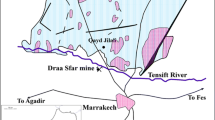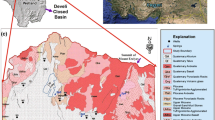Abstract
The purpose of this study is to evaluate the environmental and social impact and operational water quality in the Mahd Adh Dhahab gold mine area and its surroundings in the central part of the Arabian Shield, Saudi Arabia. This study investigates the distribution of heavy metals in the groundwater from the Mahd Adh Dhahab gold mine area and its surroundings to examine the contamination level of heavy metals in this water due to mining activities. Analytical results of 23 samples from different drains and Wadis of the study areas indicated that water has relatively high concentrations of Na (average 1,916 ppm), Al (average 1.2 ppm), Fe (average 1.2 ppm), and B (average 2.9 ppm). Other elements exist in very low concentrations (less than 0.5 ppm). The heavy metals distribution shows no specific patterns in the studied wells. Although the concentrations of some heavy elements such as Cu, Zn, and Pb are high due to their abundance in the exposed mineralized veins in the Mahd Adh Dhahab gold mine, no abnormally high concentrations of these elements were found in the studied water samples. This suggests no obvious pollution effects of the mining activities on the groundwater. Except Fe and Mn contents, the groundwater in the Mahd Adh Dhahab mine area and its surroundings have lower metals concentrations compared to the World Health Organization guidelines for drinking water quality and water quality criteria for livestock set by the Ontario Ministry of Environment, which can indicate the validity of such water as drinking water after treatment for Fe and Mn. The concentrations of heavy metals in the studied water samples also have very low values compared to the Desirable Contaminant Concentration and Acceptable Contaminant Concentration values suggesting no pollution effect of the mining processes on the water quality. This in turn indicates the validity of the water in the mine area as well as the surrounding areas for agricultural uses.











Similar content being viewed by others
References
Abdullah MA, Al-Mazroui MA (1998) Climatological study of the southwestern region of Saudi Arabia. I. Rainfall analysis. Clim Res 9:213–223
Abouammoh AM (1991) The distribution of monthly rainfall intensity at some sites in Saudi Arabia. Environ Monit Assess 17:89–100
Afifi AM (1990) Environments of gold telluride mineralization in the Mahd Adh Dhahab district, Arabian Shield. Ph.D. dissertation, Ann Arbor Univ of Michigan, p 208
Al-Awadi E, Mukhopadhyay A, Akber A, Hadi K (2003) Distribution of selected trace constituents in the ground water of Kuwait. Adv Environ Res 7:367–380
Al-Hobaib AS, Al-Jaseem QK, Hassan MB et al. (2011) Environmental impact assessment of the Mahad AD’Dhahab gold mine, Saudi Arabia. Arabian Journal of Geosciences (in press)
Al-Mazroui MA (2010) Calibration of TRMM rainfall climatology over Saudi Arabia during 1998–2009. Atmospheric Research 99(3–4):400–414. doi:10.1016/j.atmosres.2010.11.006
Azcue IM, Nriagu IO (1993) Arsenic forms in mine polluted sediments of Moira Lake, Ontario. Environ Int 19:405–415
Barcelona M, Keely J, Pettijohn W, Wehrman A (1990) Contamination of ground water: prevention, assessment, and restoration, pollution technology review no. 184. Noyes, Park Ridge
Caritat P, Danilova S, Jaeger O, Reimann C, Storro G (1998) Groundwater composition near the nickel-copper smelting industry on the Kola Peninsula, central Barents Region (NW Russia and NE Norway). J Hydrol 208:92–107
Collenette P, Grainger DJ (1994) Mineral Resources of Saudi Arabia. DGMR Special Publication SP-2, Ministry of Petroleum and Mineral Resources, Directorate General of Mineral Resources, Jeddah, Kingdom of Saudi Arabia, p322
Davis SN, DeWeist RJ (1966) Hydrogeology. Wiley, New York
Dinelli E, Lucchini F, Fabbri M, Cortecci G (2001) Metal distribution and environmental problems related to sulfide oxidation in the Libiola Copper Mine Area (Ligurian Apennines, Italy). J Geochem Explor 74:141–152
E-Tech International (2010) Evaluation of predicted and actual water quality conditions at the Marlin Mine, Guatemala. Internal Report, p 87
Fang W, Huang ZY, Wu PW (2003) Contamination of the environmental ecosystems by trace elements from mining activities of Badao Bone Coal Mine in China. Environ Geol 4:373–378
Faure G (1998) Principles and Applications of Geochemistry, Second Edition, Prentice-Hall, Upper Saddle River, New Jersey, 461–484
Kemp J, Gros Y, Prian JP (1982) Geological map of the Mahd Adh Dhahab quadrangle, sheet 23E, KSA, DMMR geologic map GM – 64A, 1 pl., (1:250,000) p 39
Krauskopf KB (1979) Introduction to geochemistry. McGraw-Hill Kogakusha, Ltd., Tokyo
Martin JA, Calvert SE (2003) Hydrological and geochemical controls governing the distribution of trace metals in a mine-impacted lake. Environ Geol 43:408–418
Milu V, Leroy JL, Peiffert C (2002) Water contamination downstream from a copper mine in the Apuseni Mountains, Romania. Environ Geol 42:773–782
Piatak NM, Seal RR, Hammarstrom JM (2004) Mineralogical and geochemical controls on the release of race elements from slag produced by base- and precious-metal smelting at abandoned mine sites. Appl Geochem 19:1039–1064
Plumlee GS, Smith K, Ficklin WH et al. (1993) Understanding and predicting the composition of mine drainage waters: the importance of geological and geochemical consideration. Reviews Economic Geology, pp. 142–150
Rose R, Hawkes HE, Webb JS (1979) Geochemistry in mineral exploration. Academic, New York
Salomons W (1995) Environmental impact of metals derived from mining activities: processes, predictions, revention. J Geochem Explor 52:5–23
Senior LA and Sloto RA (2006), Arsenic, boron, and fluoride in ground water in and near diabase intrusions, Newark Basin, southeastern Pennsylvania. U.S. Geological Survey Scientific Investigations Report 2006–5261, p 105
Suthar S, Nema AK, Chabukdhara M, Gupta SK (2009) Assessment of metals in water and sediments of Hindon River, India: impact of industrial and urban discharges. J Hazard Mater 171:1088–1095
Taher S, Alshaikh A (1998) Spatial analysis of rainfall in southwest of Saudi Arabia using GIS. Nord Hydrol 29:91–104
U.S. EPA (2009) 2009 Edition of the drinking water standards and health advisories. EPA 822-R-09-011. Office of Water. Date of Update: October, 2009. Available at: http://www.epa.gov/waterscience/criteria/drinking/dwstandards2009.pdf.
Van der Leeden F, Troise FL, Todd DK (1990) The water encyclopedia, 2nd edn. Lewis, Chelsea
Williams M (2001) Arsenic in mine waters: an international study. Environ Geol 40:267
World Health Organization (WHO) (2008) guidelines for drinking-water quality. Third Edition, Incorporating the first and second addenda. Volume 1 Recommendations. Geneva. Available at: http://www.who.int/water_sanitation_health/dwq/fulltext.pdf.
Acknowledgments
Authors are grateful to the King Abdulaziz City for Science & Technology, Riyadh, Saudi Arabia, for the financial support of this work and the facilities in its labs. We would also thank the manager of the Mahd Adh Dhahab gold mine for facilitating in collecting the samples from inside the mine area.
Author information
Authors and Affiliations
Corresponding author
Rights and permissions
About this article
Cite this article
Al-Hobaib, A.S., Al-Jaseem, Q.K., Baioumy, H.M. et al. Heavy metals concentrations and usability of groundwater at Mahd Adh Dhahab gold mine, Saudi Arabia. Arab J Geosci 6, 259–270 (2013). https://doi.org/10.1007/s12517-011-0344-1
Received:
Accepted:
Published:
Issue Date:
DOI: https://doi.org/10.1007/s12517-011-0344-1




